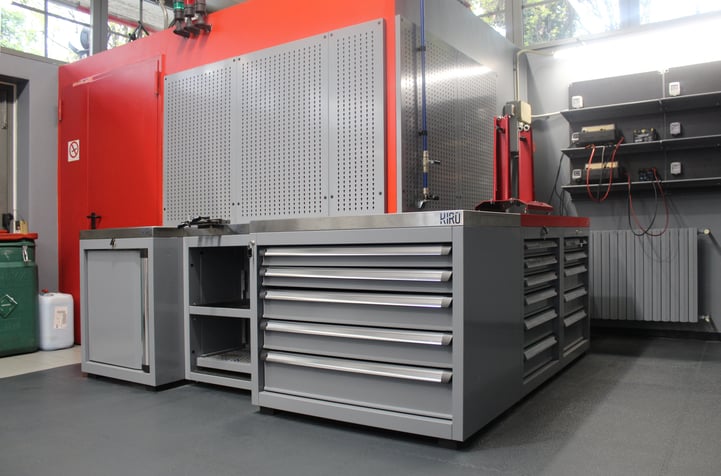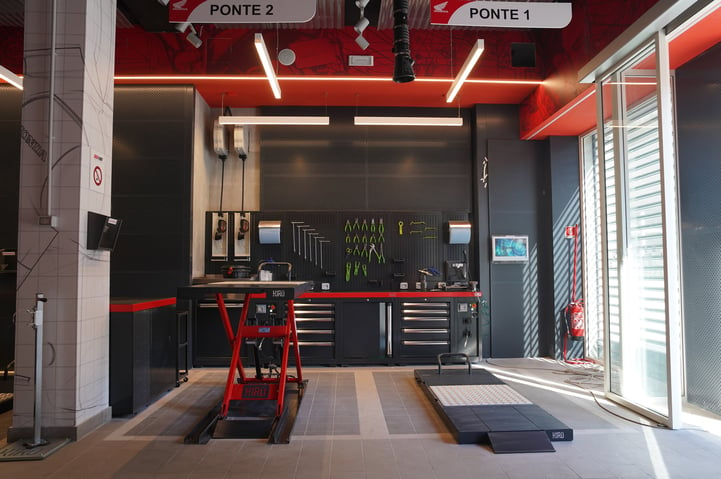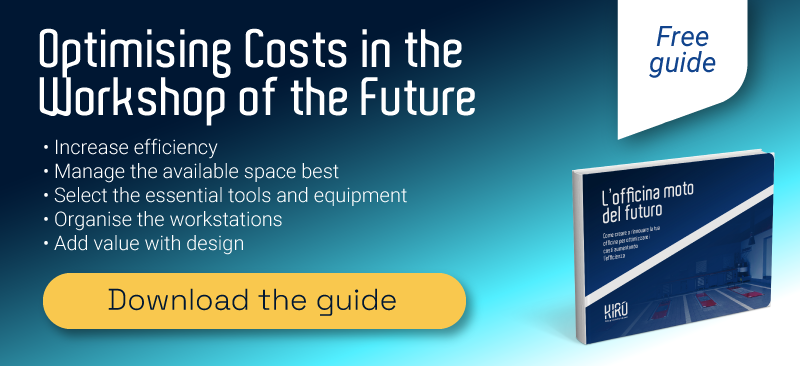The efficiency of a workshop comes from tools that don't just work, but truly support your way of working
A workbench or motorcycle lift is not just a piece of equipment: it is the beating heart of the workshop, the element that determines how fast, safe, and accurate the work will be. Those who choose KIRO are not just buying a product, but bringing a design philosophy to their workshop that combines furniture with ergonomics and durability. Every solution must be designed for those who demand the best and accept no compromises: because equipment should not only support the work, but improve it day after day.
The workshop workbench as a central tool in the design of functional workstations
The workshop workbench is the starting point for organizing your space. It is not simply a work surface: it is a modular system that must guarantee stability, order, and durability over the years. With KIRO, the workbench becomes an integral part of a working method, tailor-made for every need. Find out more about the workbench in our dedicated article!
Choosing a KIRO workshop workbench means guaranteeing solidity, precision, and durability over time.
KIRO workshop workbenches are designed to truly stand the test of time. We're not just talking about a sturdy worktop: every detail is designed to withstand heavy loads, intense workloads, and daily use without buckling. The surfaces are treated to resist oils, solvents, and impacts, while the reinforced worktops maintain stability and precision at all times.
What's more, the customizable modules allow you to configure the workstation exactly according to your needs: more drawers, storage compartments, integrated utilities. This transforms the workbench into a tool that grows with the workshop, adapting to new processes and higher workloads.
A KIRO workbench is not just a simple workstation, but a structure that becomes part of the working method and lasts for years without ever losing its reliability.
A height-adjustable workbench is the solution for improving ergonomics, well-being, and productivity in the workshop.
The height of a workbench is often underestimated, but anyone who spends eight or ten hours in a workshop knows that poor posture can reduce energy and concentration. With a height-adjustable workbench, each operator can adapt the workstation to their body type and the task they are performing.
The advantages are clear:
- Reduced muscle fatigue and back strain;
- Greater precision in delicate work;
- Greater safety in tasks requiring strength or heavy equipment;
- Consistent performance throughout the day.
This means that even after hours of work, you maintain the same productivity and quality of execution. A KIRO bench not only improves ergonomics: it improves the quality of your daily work. Discover the range of products!

With a tool bench and a wall system, you can keep things tidy and reduce your daily working time.
A workbench alone can become insufficient if tools end up scattered everywhere. That's why KIRO integrates each workstation with a tool bench and a custom-designed wall system. Every tool has its place thanks to perforated panels, shelves, trolleys, and modular drawers, so you always know where to find things without wasting time.
A tidy workshop is not only more pleasing to the eye, but also more efficient:
- It reduces downtime, because tools are immediately at hand;
- It prevents errors or misplacement;
- It conveys immediate professionalism to customers who enter the workshop.
In this way, your workspace becomes a truly organized machine: tidy, functional, and built around your method. With KIRO, you don't just “patch up” the mess, you transform your environment into a complete production system. Discover the possible configurations now!
Lifting platforms as a guarantee of safety and reliability
A lift must not simply raise a vehicle: it must guarantee absolute stability and total safety at every stage of the job. KIRO models are designed with the highest quality materials and prevention systems, because a workshop cannot afford to compromise when it comes to safety.

The KIRO motorcycle lift is the tool that makes routine maintenance safer and more efficient.
A KIRO motorcycle lift is a professional platform that guarantees stability, ergonomics, and safety in every operation. Designed for those who work on two wheels every day, it offers the solidity needed to tackle any job, from routine maintenance to the most complex repairs.
Thanks to its sturdy structure and advanced safety systems, the motorcycle remains steady and stable, allowing the mechanic to focus on the job without any worries. The ergonomics of the working position, on the other hand, reduce fatigue and intervention times, improving the overall quality of operations.
In practice, a KIRO lift guarantees:
- Faster working times, because every part of the motorcycle is easily accessible;
- Greater precision in delicate operations;
- Reduced physical effort, resulting in increased productivity;
From bike lifts to lifts for quads and microcars, KIRO offers the same attention to safety and reliability.
Not all workshops work only on motorcycles: bicycles, quads, and even microcars are now part of the daily routine for many professionals. KIRO has developed a range of lifts specifically for each vehicle, maintaining the design philosophy that characterizes all its products. Find out more in the dedicated area!
Whether it's a bike lift, a quad lift, or a microcar lift, the quality is always the same: sturdy materials, certified safety, and attention to detail. Each model is designed to ensure stability during operation and to facilitate the operator's work.
The reasons why customers choose KIRO for lifts dedicated to other vehicles are clear:
- Solutions designed specifically for each type of vehicle;
- The same reliability as motorcycle lifts, but with targeted adaptations;
- A long-term investment that supports the growth of your workshop;
- The opportunity to expand the services you offer your customers without having to change your working philosophy.
Workshop workstations: the KIRO method that integrates workbenches and lifts into a single vision
Efficiency is not achieved with isolated equipment, but with workshop workstations designed as integrated systems. KIRO designs solutions in which the motorcycle workbench, the lift, and the equipped workshop wall interact with each other, creating an integrated workstation. It is a tailor-made design that transforms the space into an ally of the working method, immediately conveying a higher level of professionalism to customers and employees.
Conclusion: choosing KIRO means investing in a better way of working
Workbenches and lifts may seem like similar products everywhere, but KIRO transforms them into tools that make a difference. They are not just equipment, but part of a system designed to improve efficiency, safety, and quality.
With KIRO, every workshop workstation becomes an organized, ergonomic, and durable environment. It's not about adding a bench or a lift, but choosing a method that reflects who you are and how you work.
FAQ: frequently asked questions about workbenches and lifting platforms
What is the ideal height for a workbench?
KIRO recommends a workbench that can be adjusted in height so that each operator can work in an ergonomic and safe position. The minimum recommended height is approximately 60 cm, with the possibility of customization according to requirements.
How to choose the most suitable workbench for your workshop?
To choose the ideal workbench, you need to consider the available space, the type of activity, and the need for accessories such as drawers and equipped walls. With KIRO, every workshop workbench is custom designed, ensuring ergonomics, durability, and an organization that reflects your working method.
What kind of maintenance do they require?
Thanks to the materials used and the special coatings, simple routine cleaning is sufficient to keep them in perfect condition at all times.
What is the best workbench for a mechanical workshop?
The best workbench for mechanical workshops is designed to withstand wear and tear and keep things organized, adapting to any working method with the quality and reliability typical of Italian-made products.
Can a motorcycle lift also be used for other vehicles?
It is better to opt for dedicated models: KIRO offers lifts for ATVs, lifts for bikes, and lifts for microcars, each with specific features designed to ensure safety and efficiency based on the vehicle to be lifted.


